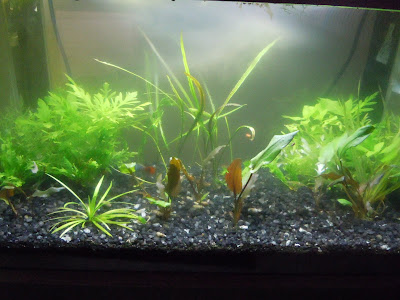An experiment with almost no-tech planted tanks
By: Wiktor
One day while surfing the web I stumbled upon a site explaining a planted tank method referred to as the Walstad method based on a methodology laid out in the book Ecology of the Planted Aquarium by Diana Walstad. After reading about it I was intrigued but found myself much too busy to try it out until several years later when spring fever caught me. I couldn’t find very detailed info about what exactly I needed to get this working but from sifting through morsels of useful information I got my materials together and began. Firstly you will need a tank, in my test run I chose a 10 gallon I had lying around and some soil. I used a composted topsoil material which I would characterize as a sandy loam and got a bag with probably enough to fill a 75 gallon for 4 dollars at Oakland Nursery. You want organic material to comprise the bulk of the soil but go composted to avoid the risk of rapid decomposition causing your tank to turn into a stinky mud puddle. I before putting in the soil rinsed it out to separate floating woody debris like sticks and such this also helped to separate out the sand giving me the better for this purpose dark rich organic material. I then placed an inch of this substrate into the ten gallon and covered it with a half inch to an inch of gravel primarily to keep the soil in place. I then planted it as you would any planted tank and voila! A little cloudy but that’s to be expected.
Tank at set up (10 gallon with the new and very sleek T5 standard strip $20 or so)
This tank has no filter for two reasons, one to prevent loss of CO2 and two to slow down the conversion of ammonia and nitrite into nitrate since aquatic plants prefer these forms of nitrogen. The foundation of the Walstad style tank is to balance plant growth with the waste and CO2 excretion of the fish and other animals inside. As this is the first such tank I have ever worked with I played it cautious and didn’t add any fish for the first few weeks to see how things went. I added some snails of various types notably malaysian trumpet snails to keep the substrate aerated and to help break down mulm.
Here is the tank at about one week, nice and clear and new growth appears.
At the one week to two week point water parameters are more or less ordinary for a newly set up tank with minimal nitrite and some nitrate and most of which likely came from the old tank water I seeded this tank with.
Tank at about a month some euglena hazing the tank but undetectable nitrite and minimal nitrate
At this point the tank has been running (figure of speech) a month and has undetectable nitrite and less than 20 ppm of nitrate after a partial water change. I have started growing a little euglena (green water) but since it is not growing much I doubt there is much nitrogen available for it. Since the tank seems stable I have added a small corydoras and a platy to add nitrogen and CO2 sources to the tank. They seem happy enough and I will keep an eye on them and the tanks parameters over the next couple weeks but so far this seems to be a resounding success and the plants are growing vigorously and I expect will grow even more lush with fish in the tank. All told if you didn’t have most or all of the supplies just lying around this is easily an afternoon project with supplies totaling 30 bucks or so assuming you can provide your own plants. I think this sort of set up would be extremely good for making a shrimp tank once you were sure the water had stabilized.
After about 3 or 4 months The tank is lush and green with not a bit of algae in sight. The Platy died somewhat unexpectedly however the Corydoras has done wonderfully and the tank could likely handle more fish.
The tank going strong at 3 or 4 months




No comments:
Post a Comment